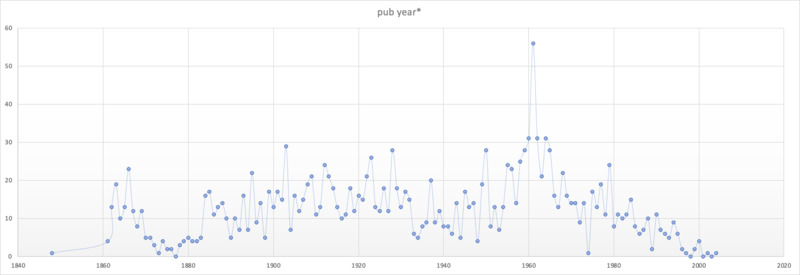A Changing Memory Mapped Out
While the Lost Cause narrative has worked its way into the minds of Americans, but it is not the history of an actual event. This mythologizing of the war, however, is not only a Southern phenomenon; the war has become a mythic event for Americans in general. Tony Horwitz penned a 2013 Atlantic article and claimed: "The Civil War today is generally seen as a necessary and ennobling sacrifice, redeemed by the liberation of four million slaves." By casting the war as an "ennobling sacrifice" for white Americans, however, it obscures the role of slavery as a cause of the war and the enslaved's leading role in their emancipation.
The graph below tracks the years the sources in our collection were published, helping us visualize when writing and reading about the Civil War were popular. In doing so, it also allows us to connect the sources in our collection to the continually changing memory of the war. Indeed, at the same time that a boom in Civil War literature and writing emerged, so too did the narrative of the lost cause.
In the end, the Civil War and its meaning are still fraught with controversy as Americans come to terms with their collective past, attempting to reconcile the truth of the past with popular memory. Many of the sources in this digital collection represent this ongoing struggle over national identity and require much thought and consideration by their readers. As previously stated, the graph above indicates when the sources in this collection were published (not necessarily when they were written), combined with the knowledge this article has provided regarding contextualizing printed sources on the war, contemporary readers can then deduce pivotal moments in the history of the war's memory. As you can see, two peak moments of publication on the Civil War are at the turn of the century (1900) and again in 1961. One peak, at the turn of the century, represents the ascendancy of the Lost Cause rhetoric, while the other marks the 100th anniversary of the war. The 1960s are also an important moment in national history as they represent the height of tensions surrounding the Civil Rights Movement. If we look again at the graph, it is also apparent that in the immediate aftermath of the war, a spike in publications immediately took place, then rapidly dropped as Reconstruction policy initially took effect across the country. The lowest point of Civil War publication was just before the Compromise of 1877 and the presidential election of Rutherford B. Hayes. The Compromise and Haye's election are frequently cited as the end of Reconstruction, coinciding with the withdrawal of most northern troops from the re-united American South.
Hayes's presidency also marks the official closing of government-sponsored Reconstruction and the simultaneous rise of nationwide reconciliation. Following the end of Reconstruction, we again see a steady rise of publications about the war, peaking around 1908, just a decade after the Supreme Court held up Jim Crow segregation in Plessy v. Ferguson, maintaining the mandate of "separate but equal." The majority ruling of Plessy v. Ferguson justified for many states and local communities to further codify and legalize white supremacy under the premise of "separate but equal." In addition to legal battles, the number of Civil War monuments erected in general and Confederate monuments specifically peaked in 1910 following the sweeping rise of segregationist legislation. In short, by placing the written texts and documents of this collection in their complex historical context, we are better equipped to understand and interpret them as not only documents about the past but how Americans have been influenced by their present when writing about the past.
